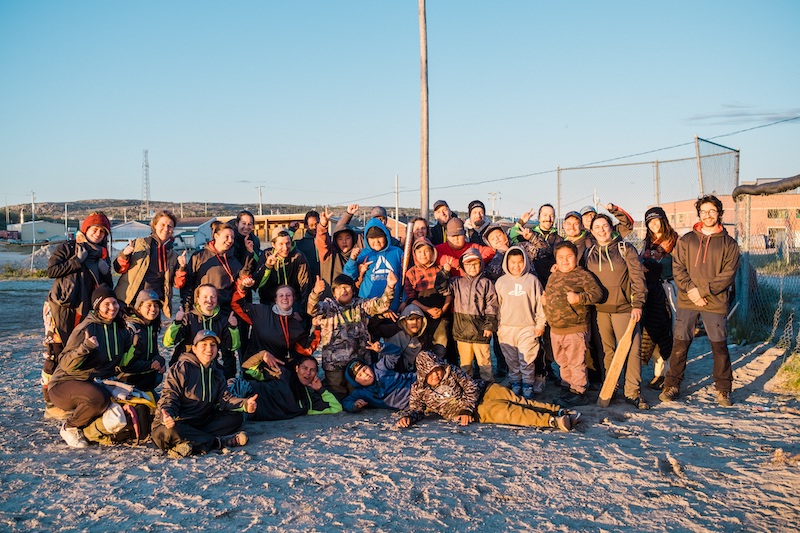A study suggested by Cree and Inuit leaders has demonstrated that essential oils from dwarf Labrador tea, or Rhododendron subarcticum, are effective against the parasite that causes drug-resistant malaria.
Labrador tea is a remedy long used by Indigenous peoples to treat a range of ailments, but a smaller shrub producing a particularly aromatic brew is only found in harsher subarctic environments near Whapmagoostui. Its chemical composition and potential antimicrobial applications were relatively unstudied the recently published findings in the ACS Omega scientific journal.
“The dwarf Labrador tea is very much used in our community every day,” said Joshua Kawapit, Whapmagoostui’s communications officer. “When I get sick, that’s the first medicine I’ll resort to as a form of detox. We wanted to know its properties and if it can cure other things we don’t know of.”
Université Laval chemist Normand Voyer, who has developed a relationship with Kawapit and other community members over several years, proposed the research study to help validate the importance of local medicinal plants. People in Whapmagoostui and neighbouring Kuujjuarapik wanted to understand whether the dwarf Labrador tea might become toxic or less effective with higher usage.
“They were interested to see the variability of the medicinal composition,” Voyer told the Nation. “We said that’s a cool idea. If that can show the rest of the world that Nunavik is an amazing place filled with molecular treasures, that would be my small contribution to showing the importance of respecting the land and communities living on that land.”
Believing Northern Quebec to be “an amazing scientific playground” with a unique ecosystem, Voyer said he intends to devote the rest of his career to demonstrating this value at the molecular level. By revealing hidden treasures in Nunavik tundra or Huron-Wendat forests, he hopes to support land-conservation efforts.
The Centre for Northern Studies at Université Laval has research stations across northern Quebec. Kawapit noted that scientists may ask communities for permission to conduct field work but rarely share their results. When consulting with the band council in 2019, Voyer promised to present his team’s work with the community first.
“We have an amazing relationship with the Whapmagoostui First Nation and are really indebted they’re trusting us,” said Voyer. “It’s a privilege, honestly, to discuss nation-to-nation. We’re in direct contact with traditional knowledge keepers and healers. We’re also working on a small booklet that could be used to talk about traditional medicine in schools.”
Voyer’s team extracted essential oil from leaves gathered in Nunavik, eventually identifying 53 compounds through gas chromatography, mass spectrometry and flame ionization detection. Results showed that ascaridole in the oil was the primary component acting against malaria-causing parasites.
The molecule ascaridole is found in different plants around the world, including one used by Indigenous communities in Mexico for its anti-parasitic properties. While malaria is a mosquito-borne disease that kills nearly a million people primarily in tropical regions every year, it shares certain properties with other types of parasites.
“It demonstrates the impact some of these natural medicines can have around the globe,” Voyer explained. “When you eat raw meat, you can get several different parasites. Indigenous communities know how to take care of themselves with medicine to treat parasites that enter their food chain – another lesson we’re learning from traditional knowledge.”
While the study’s results suggest that molecules from dwarf Labrador tea could be extracted and reproduced in the lab to develop a malaria treatment, Voyer emphasized he has no interest in patenting or profiting from this research. However, he supports potential commercial applications initiated by the Cree Nation if it so chooses.
“If the World Health Organization synthesizes that to develop a medicine, they would have to sign agreements with the Cree Nation to recognize their contribution,” said Voyer. “There is absolutely no idea for harvesting these plants to save the Africans from malaria. We’re trying to show nature is providing us clues to treat malaria with natural substances.”
The study’s results, which emphasized protecting rapidly changing northern ecosystems, were presented to the Whapmagoostui council last year. The community is interested in documenting the impacts of invasive shrubbery that can prevent sunlight from reaching lower plants and lichens.

“We’re working with a dwarf birch tree that’s progressing north very rapidly,” explained Voyer. “Nothing is known about this shrub. We’re trying to find out if there’s anything useful that could be transferred to the Cree and Inuit so they could potentially harvest it and develop a local economy.”
Research on dwarf Labrador tea is likely to continue further north, collecting samples in different seasons to determine the chemical composition’s variability, which can significantly influence its medicinal properties. While essential oil is easier to study, the team now wants to follow local recipes with community members to document how the herbal tea is traditionally prepared, analyzing its chemistry to support tradition knowledge.
Past studies conducted with the Cree Nation have shown regular Labrador tea extracts to effectively treat symptoms associated with diabetes. It’s been used to counteract all types of pain, including respiratory, digestive and kidney problems, rheumatism, scurvy, easing labour and purifying blood. However, some sources suggest concentrated doses could be toxic.
Voyer looks forward to resuming his research and recounted fond memories of playing baseball with summer students and local children. As the principal organizer of the Quebec Indigenous Science Fair in March, he was impressed by presentations from budding scientists from Chisasibi and Mistissini.
Kawapit believes the collaboration is inspiring more of his community’s youth to consider science careers. Asserting that the pharmaceutical industry caused substantial loss of traditional medicine practices, he said he’s not surprised this study is confirming health benefits found in local plants.
“There’s certain knowledge our Elders possess that was never really written,” said Kawapit. “Other people may now start to understand our knowledge is as valuable as the scientific community. We can validate everything we’ve been saying all along.”
by Patrick Quinn, Local Journalism Initiative Reporter





